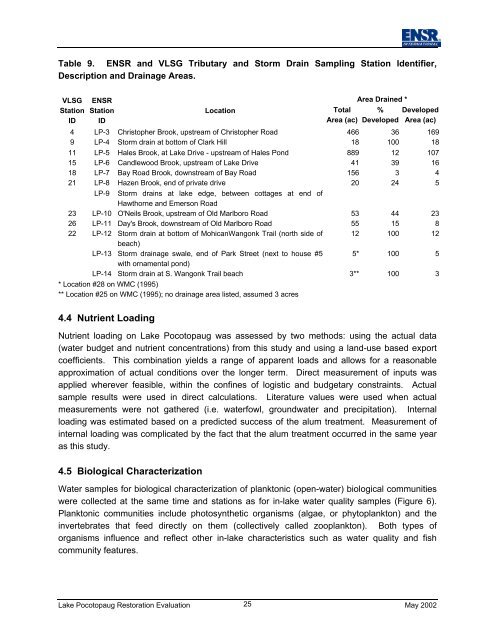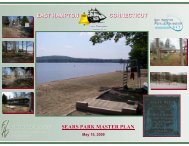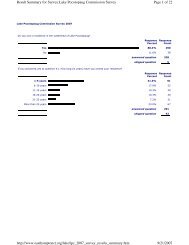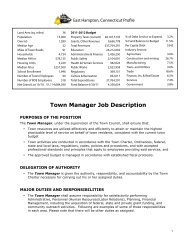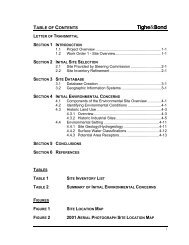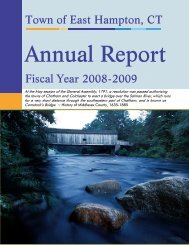Lake Pocotopaug Lake and Watershed Restoration Evaluation ...
Lake Pocotopaug Lake and Watershed Restoration Evaluation ...
Lake Pocotopaug Lake and Watershed Restoration Evaluation ...
Create successful ePaper yourself
Turn your PDF publications into a flip-book with our unique Google optimized e-Paper software.
Table 9. ENSR <strong>and</strong> VLSG Tributary <strong>and</strong> Storm Drain Sampling Station Identifier,Description <strong>and</strong> Drainage Areas.VLSGStationIDENSRStationIDLocationTotalArea (ac)Area Drained *% DevelopedDeveloped Area (ac)4 LP-3 Christopher Brook, upstream of Christopher Road 466 36 1699 LP-4 Storm drain at bottom of Clark Hill 18 100 1811 LP-5 Hales Brook, at <strong>Lake</strong> Drive - upstream of Hales Pond 889 12 10715 LP-6 C<strong>and</strong>lewood Brook, upstream of <strong>Lake</strong> Drive 41 39 1618 LP-7 Bay Road Brook, downstream of Bay Road 156 3 421 LP-8 Hazen Brook, end of private drive 20 24 5LP-9 Storm drains at lake edge, between cottages at end ofHawthorne <strong>and</strong> Emerson Road23 LP-10 O'Neils Brook, upstream of Old Marlboro Road 53 44 2326 LP-11 Day's Brook, downstream of Old Marlboro Road 55 15 822 LP-12 Storm drain at bottom of MohicanWangonk Trail (north side of 12 100 12beach)LP-13 Storm drainage swale, end of Park Street (next to house #5 5* 100 5with ornamental pond)LP-14 Storm drain at S. Wangonk Trail beach 3** 100 3* Location #28 on WMC (1995)** Location #25 on WMC (1995); no drainage area listed, assumed 3 acres4.4 Nutrient LoadingNutrient loading on <strong>Lake</strong> <strong>Pocotopaug</strong> was assessed by two methods: using the actual data(water budget <strong>and</strong> nutrient concentrations) from this study <strong>and</strong> using a l<strong>and</strong>-use based exportcoefficients. This combination yields a range of apparent loads <strong>and</strong> allows for a reasonableapproximation of actual conditions over the longer term. Direct measurement of inputs wasapplied wherever feasible, within the confines of logistic <strong>and</strong> budgetary constraints. Actualsample results were used in direct calculations. Literature values were used when actualmeasurements were not gathered (i.e. waterfowl, groundwater <strong>and</strong> precipitation). Internalloading was estimated based on a predicted success of the alum treatment. Measurement ofinternal loading was complicated by the fact that the alum treatment occurred in the same yearas this study.4.5 Biological CharacterizationWater samples for biological characterization of planktonic (open-water) biological communitieswere collected at the same time <strong>and</strong> stations as for in-lake water quality samples (Figure 6).Planktonic communities include photosynthetic organisms (algae, or phytoplankton) <strong>and</strong> theinvertebrates that feed directly on them (collectively called zooplankton). Both types oforganisms influence <strong>and</strong> reflect other in-lake characteristics such as water quality <strong>and</strong> fishcommunity features.<strong>Lake</strong> <strong>Pocotopaug</strong> <strong>Restoration</strong> <strong>Evaluation</strong> 25May 2002


